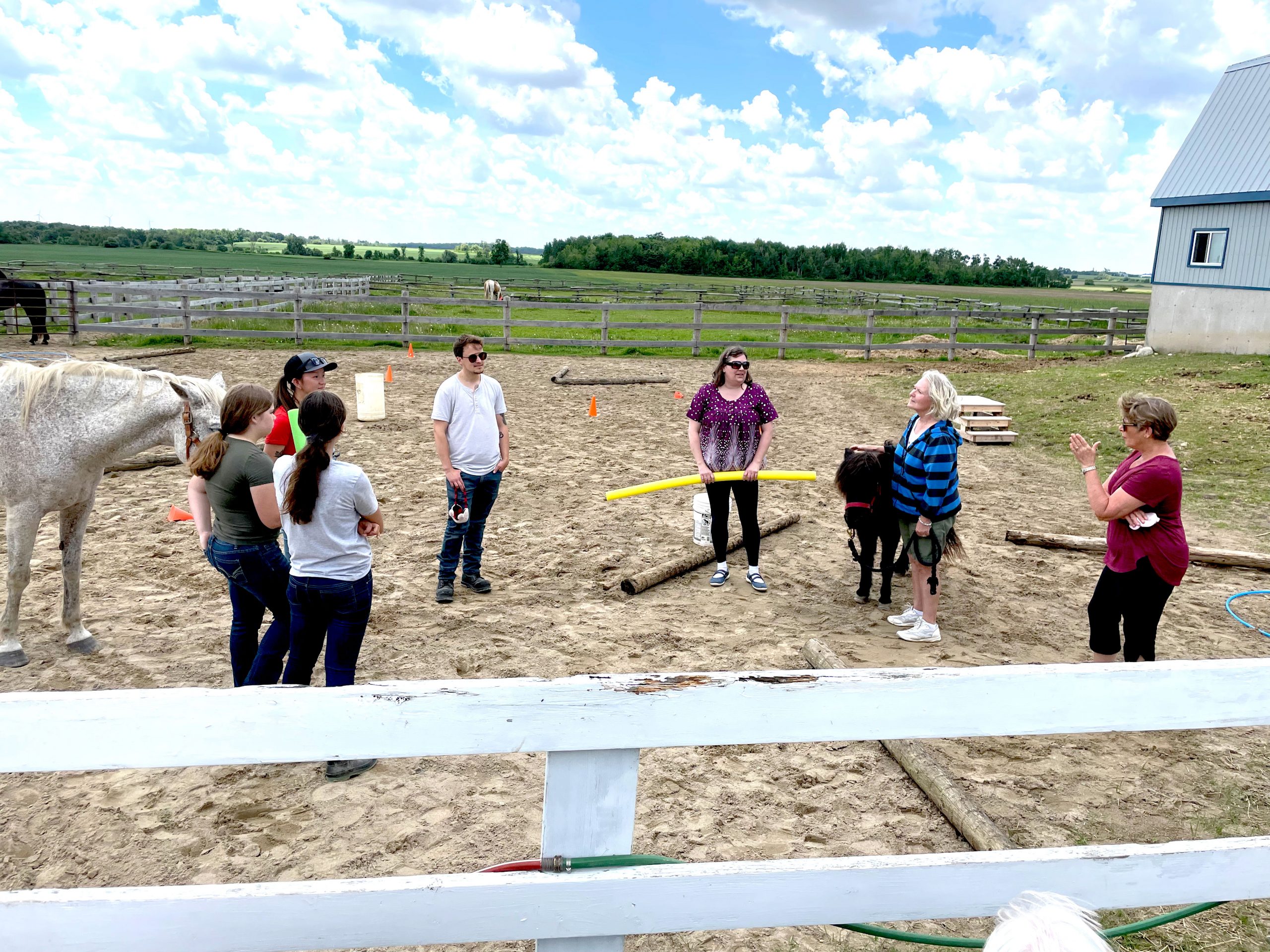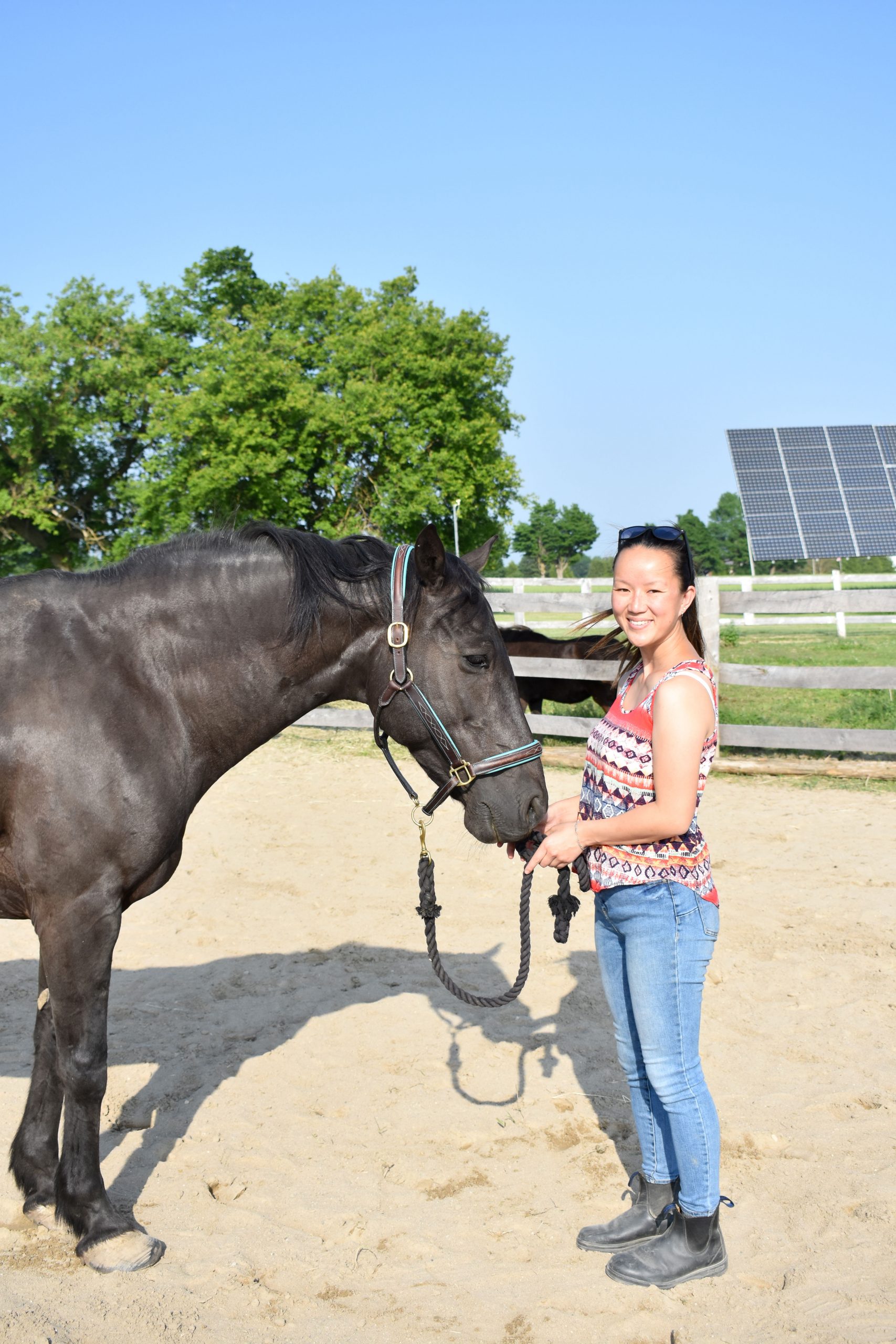CENTRE WELLINGTON – You just never know when greener pastures will appear and alter your career trajectory.
For Leanne Matthews, a reunion between two old college friends introduced her to Heather Burns, and that opened the field gates to allow Matthews an opportunity to pursue her desire to work with horses.
“The backstory to it all is Leanne’s mom and I were best friends in college. And we reconnected after my husband and I came back from Saskatchewan, where we’d been farming for the six years,” explained Burns, who owns Burnsdale Farm alongside her husband Keith.
“Leanne came out for a visit to see the horses and spoke about wanting to do something with horses in her career.”
Matthews, who was raised in Guelph, rode horses for about 15 years in her youth, competing in the hunter arena.
“I have a huge passion for working with horses,” Matthews said, noting she thought her horse riding days were behind her after pursuing post-secondary studies and a career away from her equine interest.
Burns suggested Matthews investigate the study of equine assisted learning (EAL).
A hands-on and practical approach to learning, EAL brings people and horses together to develop, visualize and learn life skills such as communication, leadership, self-confidence and teamwork. It also allows the individual to experience self-growth.
“It’s a way of experiencing life skills and growing on them using just groundwork with a horse,” said Matthews. “So, no riding component is involved and absolutely no horse experience is needed.”
EAL programs are designed for groups of two to four people who work together, alongside their equine companion, to navigate obstacles with the goal of empowering participants in areas such as problem solving, negotiation, boundaries and trust building.
“In terms of leadership, we have to be able to control that horse, and often times we put them in groups as well with other people,” Matthews explained.
“So, participants are put into that leadership role in order to successfully make it through the course.”
An example of an EAL scenario would be to have two individuals working with one horse.
“The person with the horse is blindfolded, and their partner has to stand off to the side and verbally communicate with their partner and the horse, how to make it through the obstacle,” she explained.
“It’s something that can be as small as just walking around a barrel, or we have more challenging ones where it’s walking through an actual setup obstacle course.”
To work on communication, a horse will have two lead lines, held by a person on each side. The goal is to communicate together to manoeuvre the horse through an obstacle without getting too close to the horse.
“A lot of it is just based on problem solving of how do you weave this horse through a pylon when I’m way over here, you’re way over here and the horse is in the middle?” Matthews said.
The program is adaptable to the goals of the individual or group participating.
“All the sessions are very unique. We tailor them to everyone’s comfort level and their experience and essentially what they want out of it,” Matthews said, noting it is her role to understand peoples’ triggers or confidence with the horses. In some cases, a session could begin by simply brushing the horses, to get comfortable around the animal.
“To begin, I ask the participants what they want to get out of the session,” Matthews said. “If they don’t know what they want to achieve right away, we just start with the very basic communication, obstacles and build our way up from there.”

Practice session – During a June open house, LM Equestrian Center near Belwood welcomed the public to try some equine assisted learning obstacle courses. Submitted Photo
Horses are ideal for this kind of work, Matthews explained, because of their honest behaviour and reactions. As prey animals, they have a strong flight sense, seeking out strong leadership.
Their large presence commands an element of respect, yet they are highly intuitive animals, with the ability to tune into a human’s body language and emotions, offering instant feedback.
“The way a horse reacts will often tell us much more about ourselves than a typical human interaction ever could,” she said.
“These interactions are the core of all EAL programs and by reflecting on them, we can gain insight to ourselves.”
For example, Matthews said if an EAL participant is stressed or having a challenging time in an obstacle with their equine partner, they can look to the horse to see the response.
“We can kind of look at the horse and say, ‘okay, this horse is confused.’ You can tell it’s not relaxed right now. And how do you think that reflects on your body language?” Matthews said.
She noted reflecting on their own body language and how they are presenting confusion and feeling flustered, helps participants regain their composure.
“Let’s just take a deep breath and calm down. And when they are relaxed, the horse will relax. And then we’ll draw that parallel again.”
It was something Burns experienced firsthand as a foster parent during her time in Saskatchewan. With six teen girls in her care, she saw first-hand the impacts of the horse-human connection.
“I had the opportunity to put them in [a six-week EAL program]. And I was watching them do what Leanne is now doing,” Burns said. “As a caregiver, I was able to pick up a lot about them – how these girls react and where they’re weak, where they’re strong. But for them, they also started discovering who they were.”
A retired dairy farmer who had never before owned horses, Burns knew her new family property back in Ontario would have a barn.
“So that’s what I wanted to be able to provide, is just help for foster children,” Burns explained. “They get the short end of a lot of sticks.”
With Matthews’ interest in building a career with her equine skills and a small herd of horses at the ready, the visit to Burnsdale Farm was kismet.
Burns offered the space and the means required for Matthews to pursue her goal.
“It’s how we live our lives actually, is to help people. And we can help people accomplish their dreams and goals on this farm. It’s just very rewarding,” Burns said. “I wanted this program to run and I didn’t want to be the spokesperson. It just so happened Leanne came along and it was a perfect fit.”
She added, “it was just a dream of mine to do this. Now we’re building an indoor riding arena so that Leanne can do this year-round.”
The pair decided to focus primarily on youth in foster care or low-income communities, but want to create a program where EAL is open to all who will benefit.
“One of our focuses is on youth,” Matthews confirmed.
“What EAL really helps them with is their confidence, and their leadership skills. And then we build on that to help kind of involve with their teamwork, communication, and trust. But the biggest thing is their confidence, we find.”
Therein lies the reward for Matthews.
“It’s really hard to find the words,” she said, of the satisfaction in her work with youth. “It’s kind of that feeling of, this may seem small to me, but it could be life changing for them, just in such a small moment.”
EAL is also suited for corporate retreats, youth groups or other social gatherings, including ladies nights or couples date nights, with customizable programming to suit the situation in a one-hour session.
“We recently had a group of four ladies come out that have been like longtime friends. We just ran them through a few trust-building and communication exercises, and they actually learned their communication styles from that.
“Even though they’ve been friends for 40 years, they learned something new about each of them. So, it can be a fun group night out,” Matthews said.
“And then we can also run date nights as well. Trust building is a huge one for them, and communication as well. So, it’s kind of a fun way of exploring that.”
Matthews obtained her EAL certification through the Dreamwinds Equine Assisted Learning Centre in Bradford, through a series of online courses and in-person training offered during the pandemic.
Dreamwinds is a licensed partner of Cartier Farms, in Saskatchewan, the founders of the EAL Building Block Curriculum.
“Dreamwinds was such a supportive and encouraging experience and allowed us to see first hand, the power that equine assisted learning can have,” Matthews said.
“When I graduated, I instantly became part of a community that shows nothing but support for one another.”
With the certification complete, LM Equestrian Center opened this spring. Working with youth is not new to Matthews. She volunteered at Sunrise Therapeutic Learning and Riding Centre in Puslinch, working with special needs youth and adults.
“That’s a different type of therapy from what I’m doing now, as they focused on the riding aspect,” Matthews said.
“But just being able to work there and see the difference it can make for kids to be able to have that connection with a horse, that’s something that was really cool to see.”
Matthews added, “Especially in my teenage years, it really changed my outlook of how fortunate I am. So, having the opportunity to now give that back to others is something that I’m really excited to do.”
A future goal closer to her heart is to expand the LM Equestrian Center programs to include work with veterans.
“I was an Army Reservist out of 31 Service Battalion, Hamilton, for five years,” Matthews explained.
“I do want to reach out eventually, and work with groups like Veterans Affairs, working with PTSD, but I need a lot more education on that realm. But it’s a goal, absolutely.”
For now, Matthews is keen to see her vision for LM Equestrian Center helping not only youth, such as foster children, with six-week programs, but also offering opportunities for the foster parents and caregivers that support them.
Growing the business, she hopes to educate people on the benefits of EAL programs. And that means, happily, being back in the ring fulfilling her dream to work with horses, all with a purpose to help others.
LM Equestrian Center is located at 7026 East-West Garafraxa Townline, northwest of Belwood. For more information, visit www.lmequestriancenter.ca or contact LM.EquestrianCenter@gmail.com or via Facebook @LMEquestrianCenter.




